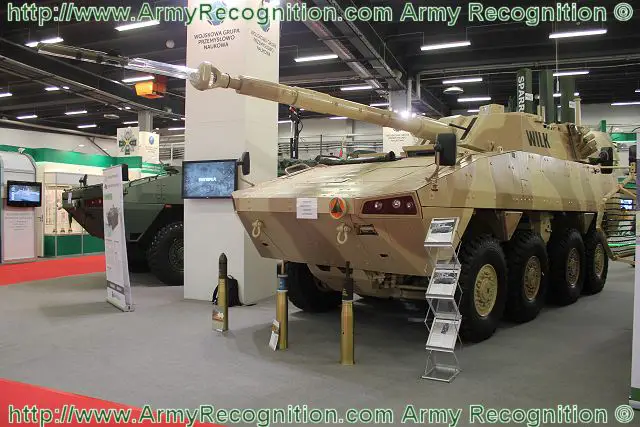Vielä tietoa CT-CV 105mm tykkijärjestelmästä:
The Cockerill CT-CV 105HP turret incorporates a Cockerill 105mm high-pressure gun with an advanced autoloader to yield high lethality at very light weight. The system provides exceptionally flexible organic fire-support to high-mobility formations.
.The CT-CV turret has been subjected to a rapid development program in parallel with a series of tests and trials in Switzerland and the UK throughout 2004 and 2005. To meet the present and future requirements of modern armed forces for powerful weapons, CMI Defence introduced the Cockerill CT-CV 105HP Weapon System (gun and turret). The two-man turret and gun have been completely developed in-house by CMI using its long experience. The system is compatible with all current NATO 105mm ammunition but the barrel has been designed to be able to fire ammunition with higher pressure as well as smart ammunition and guided missiles. The Cockerill CT-CV 105HP Weapon System is a fully stabilized turret allowing firing on the move and at moving targets.
The Cockerill CT-CV 105HP is definitely the most advanced and innovative system available today to serve the needs of modern armed forces. This turret is specifically designed for air-transportable light armored vehicles. CMI-Defence presents at Eurosatory 2010 the Falarick 105, the new anti-tank guided missile launched from the Cockerill CV gun. It’s in Scotland that CMI has demonstrated the effectiveness and accuracy of the Cockerill CT-CV 105HP Weapon System gun launched missile which provides a High anti-tank lethality at extended ranges and confirms the positioning of this turret system as an advanced 105 mm, the benchmark in large calibre weapon systems.
The combined mobility, lethality, engagement envelope and operational flexibility of the Cockerill CT-CV 105HP weapon system is unrivalled.
The 105 mm CV rifled gun is fitted with a single-stage muzzle brake, thermal sleeve and fume extractor.
To reduce recoil forces below 150 kN, the barrel is fitted with a highly efficient muzzle brake and two parallel recoil brakes. The barrel is of Electro-Slag Refined (ESR) steel and has a 20 per cent supplementary pressure margin for future growth potential. It is fitted with a semi-automatic vertical sliding breech mechanism and an electrical ignition mechanism. The 105 mm CV rifled gun can fire all NATO standard ammunition to defeat armour, troops, weapon emplacements, bunkers, fortified structures, buildings and similar. In developing the weapon other
ammunition related developments have been taken into account, including smart ammunition and guided munitions. Particular attention has been paid to safety and comfort of the crew. The crew is seated low in the turret to take advantage of the vehicle hull protection. For safety reasons too, the crew and ammunition compartments are independent and separated by a firewall; in addition, crew protection is ensured thanks to a safety fuse plate above the ammunition rack.
The Cockerill CT-CV 105HP turret is equipped with a full autoloader ammunition rack, with a capacity of 12 ready rounds in lightweight configuration, and 15 ready rounds in standard configuration (additional rounds will be stowed in the vehicle allowing reloading under armor). After tests in Scotland during year 2010, the Weapon System Cockerill CT-CV 105HP can firing now the anti-tank missile Falarick 105 from the Cockerill 105 mm CV gun. With its laser beam guidance system,
the Falarick 105 is able to wipe out fixed & moving armoured targets, helicopters and fortifications at a distance of 10 kilometres in indirect engagement thanks to its +42° gun elevation. Its tandem hollow-charged warhead allows it to destroy targets under 550 mm of armour and behind ERA or their equivalent.
The Cockerill CT-CV 105HP Weapon System Turret is equipped with an automatic loader which contains 16 rounds in standard configuration and 12 rounds in air-deployable configuration. The sighting system for both the gunner and the commander consists in two identical displays, one for day vision and the other one for night vision. A panoramic sight gives the commander observation and hunter killer capabilities. Back up devices are foreseen to allow continued use of the turret in case of loss of electrical power supply.
One of most striking features of this new system resides in its BLOS (Beyond Line of Sight) firing capabilities thanks to a +42° gun elevation, adapted to urban and mountainous warfare conditions as well as allowing firing against airborne targets.
http://www.armyrecognition.com/belg...rill_gun_vehicle_design_development_prod.html
Linkin perusteella on nähtävissä että CT-CV 105mm ei ole versio brittiläisten L7 -tykistä 1940-50 luvulta vaan täysin uusi, moderni korkeapainekanuuna joka kykenee ampumaan uusimpia korkeapaine-ammuksia sekä lähitulevaisuuden ammuksia.
CT-CV 105mm kanuunan epäsuorantulen kyky siis selvisi: aseella voidaan ampua Falarik-PST ohjusta epäsuoralla tulella 10 km etäisyyksille. Tämä tarkoittaa lähes kaksinkertaista kantamaa venäläisiin 9M119M Reflex-ohjuksiin nähden. Toinen vaihtoehto on IMI:n LAHAT (105mm/120mm) joka käy myös Leo 2 vaunuihin. Sen kantama on 8 km eli lyhyempi kuin Falarikilla mutta LAHAT läpäisee jopa 800mm panssaria. Ainakin LAHAT hyökkää kohteeseensa yläkulmasta eli iskee heikoimpaan kohtaan vaunussa. Näin tehokas tst-kärki ja hyökkäyskulma takaavat että parhaatkin vaunut tuhotaan. Myöskään venäläiset Shtora ja Arena-puolustusjärjestelmät eivät kykene torjumaan ylhäältä hyökkäävää ohjusta (mm. Spike). Ainakin LAHAT voidaan laukaista täysin suojasta, ilman suoraa näköyhteyttä jos ulkoinen laserosoitus on käytettävissä.
http://www.defense-update.com/directory/lahat.htm
Tuo ohjus on toki vain tehokas lisä järjestelmään eikä sinänsä riitä perusteeksi hankinnalle. Tärkeintähän olisi saada 30mm tykeillä varusteltuja Rpsv:ä hankittua niin että suoja ja tulivoima lisääntyisivät. AGS oli vain lisäpohdinta joukkojen tukemiseksi liikkuvassa taistelussa ja tulivoiman parantamiseksi. Ei ehkä toimi kuitenkaan meillä kovin hyvin ja rahaahan tuohon palaisi. Yritin kerrankin ehdottaa jotain ilman ensimmäistä ajatusta rahasta mutta realiteetti hillon suhteen on liikaa nykyään eikä "laatikon ulkopuolen" pohdinnat ole hyväksyttäviä. Palaan ruotuun ja inhorealismiin....
Jos telakalusto kiihottaa niin ainahan olisi tuo erinomainen ja halpa ruotsalainen CV90120-T :
Vaunussa on 120mm L50 vaunukanuuna joka ampuu moderneinta shittiä mitä lännestä löytyy, aktiivinen puolustusjärjestelmä, automaattilataus ja.... ne telat

Tosin tuokaan vaunu ei kestä 125mm APDS-ammusta, HEAT- tai ohjuksia jos soft-kill järjestelmä ei niitä poimi (nuolta ei kykene). En kyllä usko että mikään vaunu idässä tai lännessä kestää 1-1,5 km etäisyydellä ammuttua APFSDS ammusta edestäkään. Suomessa tunnetusti ei ole mittavia aroja tai peltoja idässä tai etelässäkään että panssarijoukot voisivat hirveästi levittäytyä maksimoiden tehonsa. Enemmän taistellaan urilla ja niiden lähellä sekä asutuskeskuksissa. A-etäisyydet ovat lyhyempiä kuin Ukrainassa, Irakissa tai euroopassa. Eniten vaikuttaa se kuka näkee ja ampuu ensin ja tämä taas luo painopistettä koulutukseen ja tiedusteluun/valvontaan.
Kun 30mm tykin tehoa pohdittiin niin tässä pätkässä testataan USMC:n EFV-taisteluajoneuvon(peruutettu) 30mm Bushmaster II tykin (CV9030) ja sen eri ammusten tehoa maa- ja merimaaleihin, eri etäisyyksillä. Testissä ammutaan mm. jv-maalia Nammo-Raufoss MPLD-T (800m)ja T-55 sekä BMP-1 maaleja APFSDS-T ammuksilla (1500/3000m). Lisäksi veneitä ammutaan 3 km:n päästä ja lähempää. Video on vanha, n. 2000-luvun alusta ja heikkolaatuinen.



